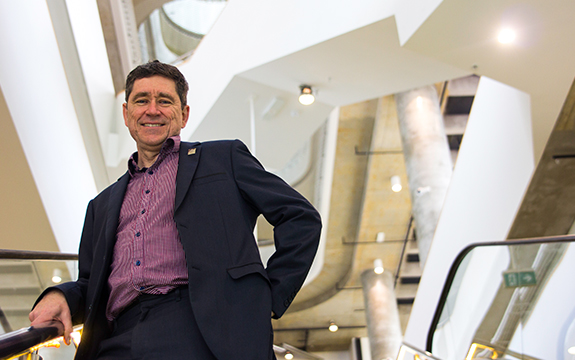Swinburne leads ARC Centre of Excellence Gravitation Wave Discovery

In Summary
- This article originally featured in Swinburne’s Venture magazine
"It's a wonderful thing to lead a massive national centre to undertake the first detections of gravitational waves and understand what they mean for the universe."
In January 2017, the Australian Research Council’s (ARC) Centre of Excellence for Gravitational Wave Discovery – or OzGrav, if you’re in a hurry – will begin operation. The Centre is not a place, but a collaboration of teams from six universities operating under the leadership of Professor Matthew Bailes at Swinburne.
OzGrav will capitalise on more than 30 years of Australian expertise in gravitational wave and pulsar science to explore the extreme physics of black holes and warped spacetime.
The other universities involved are: Australian National University, the University of Western Australia, University of Adelaide, Monash University and the University of Melbourne.
OzGrav was one of only nine Centres of Excellence to win $31.3 million funding from ARC. Its 566-page application, co-ordinated by Professor Bailes, was given a timely boost late in the submission phase by the breakthrough detection of gravitational waves in September 2015 by the Advanced Laser Interferometer Gravitational-Wave Observatory (aLIGO) in the US. Until that announcement, the existence of gravitational waves was purely theoretical.
“We were very fortunate that the detection of gravitational waves was published just prior to the final interviews,” Professor Bailes says. “That was vital timing for us.
Several Australian scientists were involved in building the aLIGO detector and its elements. With expertise in the instrumentation side, Professor Bailes went on to build a team to analyse the masses of data gleaned from the operations (collated with the use of supercomputers) and to comprehend its astrophysical implications.
“Part of my role as director is to ensure we focus on large, significant projects and that we use our critical mass to solve problems while they’re topical,” he says.
Professor Bailes’ other aim is to ensure the teams collaborate effectively. “I want to create a champion team as opposed to a team of champions.”
21st century science
Dr Yuri Levin from Monash University is one of the members of the team.
“Ultimately, my interest is the life story of these black holes,” Dr Levin says.
“How did they come to be where they are? Are they hairy or not hairy?”
“Hairiness” refers to the no-hair theorem, the conjecture that black holes have only three externally observable characteristics – mass, electric charge and angular momentum. They are otherwise “bald”, with all other information trapped behind a black hole’s event horizon.
Dr Levin has no doubts about the importance of OzGRav’s work. “The detection of gravitational waves will probably be the defining moment for 21st-century science,” he says.
“It opens up a whole new world of science, which means new technologies, new skills and new applications – good for the understanding of the universe, and good for the broader world of industry and technology in which we live.
“This is an incredible training ground for the engineers, physicists, chemists and data analysts of the future.”
Deeper discovery
Associate Professor Jeff Cooke, a Swinburne astrophysicist whose expertise lies more with galaxies and supernovae than black holes, is working with OzGRav from another angle.
He’s part of a major project called Deeper, Wider, Faster that is working to find counterparts to fast radio bursts and other extremely fast and transient astronomical bursts of energy. Gravitational waves do not emit light, but some transient phenomena – including supernovae and their smaller cousins, kilonovae – can emit both light and gravitational waves.“
Certain supernova explosions are also expected to cause a gravitational wave when the core collapses,” Dr Cooke says.
“The Deeper, Wider, Faster program searches for the fastest explosions in the universe. We focus all kinds of telescopes – gamma ray, X-ray, ultraviolet, optical, infrared, radio, both ground- and space-based telescopes, everything – on a section of the sky and look for these explosions, which can be over in milliseconds.”
While all of these telescopes are focused in one direction, they pick up a range of signals, he says.
“We get all this data from looking at massive volumes of sky and we find things like supernova shock breakouts, kilonovae, flare stars and other exotic events.”
This is where it all comes together with OzGRav. When the gravitational wave teams detect an event, they can get Dr Cooke’s team to accurately locate it, learn its distance, and to see what other signals surround it. It’s possible that so many other telescopes trained on the site will find other tell-tale astrophysical features that accompany, or are caused by, the waves.
“But that’s a reactive stance,” Dr Cooke says. Observations can go the other way, too. If his team detects fast transient events such as kilonovae – which can also produce gravitational waves – they can alert the gravitational wave team to recheck its data for information that might have initially been dismissed as insignificant.
New ideas
OzGRav is an opportunity to be involved in exploring new ideas in extreme physics and new ways of thinking about the universe. It’s a chance to work with the best people from around the world in a field Dr Cooke refers to as “essentially astronomy reborn”.
The study of gravitational waves is the exploration of whether Einstein’s theories hold, and what that means for understanding the universe.
For Professor Bailes, involvement in OzGRav is the culmination of a career that began with studying Einstein’s general theory of relativity.
“In 1984, there was very little hope in the near future of ever detecting gravitational waves. Thirty-two years later, it’s a wonderful thing to lead a massive national centre to undertake the first detections of gravitational waves and understand what they mean for the universe.”

